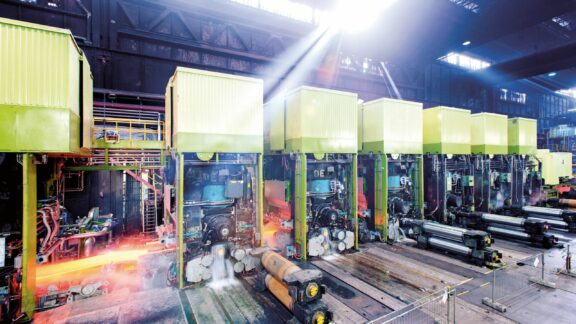The main challenges facing today’s basic and process automation systems for hot-strip mills are the reduction of strip-width deviations and the avoidance of below-minimum widths after the finishing mill, which is why Primetals Technologies has developed model-based strip-width control. Recognizing that tension can be used to manipulate the strip width in the finishing mill, model-based width control compensates for width deviations.
Width deviations are measured in front of and after the finishing mill. Entry-width deviation and width deviation due to inhomogeneous temperature distribution along the strip are reduced by a feed-forward width control (FFWC). The residual exit width deviation is reduced by a feedback-width control (FBWC). Moreover, the model-based feed-forward width control takes account of the effects of width spread in the roll bite as well as creep deformation between the stands. Effective width-deviation compensation using tension control is limited to low-frequency width deviations.
By default, the strip width in a hot-strip mill is determined by edging and rolling the strip in the roughing mill. The width deviation after the finishing mill arises from the width deviation in front of the finishing mill and from width-spread anomaly occurring inside the finishing mill. The behavior of width spread in a finishing mill depends on effects in roll bite and on the creep deformation between the stands, whereby the width spread in roll bite is influenced, for example, by thickness reduction, front and back tension, and the change-of-strip-crown ratio. The creep deformation between the stands depends on factors such as yield stress, strip temperature, specific tension, distance between stands, and strip speed.
Essential measuring instruments for FFWC and FBWC are standard width measurements located respectively after the roughing mill and finishing mill. In the case of a large product mix with different entry-strip temperatures to the finishing mill, a temperature measurement in front of the finishing mill improves the performance of the FFWC. The signal processing of the exit width of the roughing mill is an important component of the FFWC. It tracks the actual filtered exit width and the reference exit width of the roughing mill at the entry of the finishing mill for the FFWC.
The model-based approach ensures better strip quality and therefore improved productivity due to the decrease of overwidth. There is less off-gauge, with decreased areas close to minimum width through the reduction of reference tensions in the finishing mill, and the overall result is increased product tonnage.


